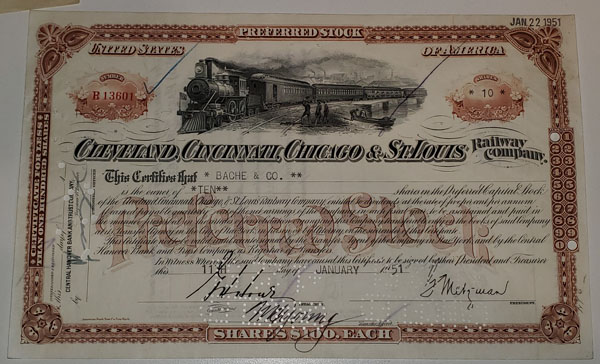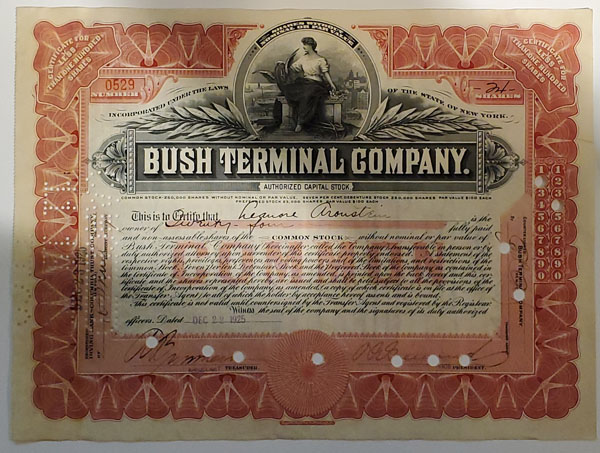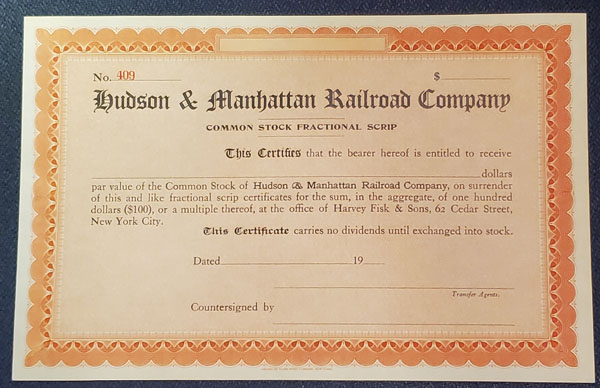
Exposure problems
Correspondents who contribute images to this project rarely tell me what kind of equipment they use. The incidence of distortion, variable focus, and variable exposure tells me that many collectors are now using smartphones to record images of their certificates. Fewer and fewer are using scanners. As a result, images are becoming noticeably poorer, not better. Exposure is generally becoming a greater issue and one harder to fix.

Dark exposure
Some of the most poorly exposed images can be found on eBay. Amazingly, sellers are actually trying to get people to buy their possessions based on terrible images! Some collectors have even told me they look for poor images. They've decided that poor imagery signals inexperienced sellers who will settle for less. I don't have the numbers to prove their theory, but I believe they have a point.
I can say that the percentage of eBay items illustrated by poor exposures moves around a bit but appears to average about 15% to 20% in the stock and bond category.
It is obvious that almost all those images come from smartphones. Let's face it, it is hard to get good images of certificates using cameras, tripods, and good lighting. Results from handheld smartphones and poor lighting are going to be notably worse.
"I'm selling just fine with photographs."
Using smartphone photos to sell a cowboy hat, a set of tires, or a snowblower is one thing. It is another thing entirely when it comes to certificates.
A scanner would probably not help much if selling one cheap certificate a month. But what if casual sellers were selling ten items a month? That's 120 items per year. If a half-decent scanner could raise bid prices only $2 per sale, it would pay for itself in a year. If sellers are claiming eBay profits on their taxes, then the reluctance to buy scanners and take deductions does not make any sense.
"I can't afford a scanner."

Shadows
The argument is completely understandable from collectors who are not (currently) selling.
The argument against using a scanner loses much of its foundation when one starts reporting profits to the IRS as a "dealer." Even as a part-time dealer. Scanners are not deductible for hobbyists, but they almost certainly qualify for ordinary business deductions.
Scanners were quite affordable a few years ago before smartphone cameras increased so dramatically in quality. These days, it is going to cost $250 and up to get a good 8½" x 11" (A4) flatbed scanner with a removable cover. A removable cover is absolutely necessary for scanning large certificates. Combination scanners and printers are much more affordable, but because their covers are not removable, they have limited ability to scan larger certificates without folding.
WARNING: NEVER run a collectible certificate through a document feeder. It might work a correctly a hundred times, but sooner or later, a destroyed certificate will emerge. (Or, more likely, be pulled out with tweezers in pieces!)
11" x 17" flatbed scanners are going to start at around $600. At that level, refurbished and used scanners become attractive options. $600-plus seems like a lot of money but is still a good deal if scanning a sufficient number of certificates and other flat items, even as a part-time "dealer." Once "dealers" start scanning inventory, they leave essentially all of their exposure problems behind. That alone can be a big time savings for sellers doing photo editing to improve their images. As a by-product, improved images decrease the inevitable downward pressure on bid prices caused by poor exposures.
Yes, dealers still need to know how to sell, but that is a different problem.
What constitutes poor exposure?

Uneven exposure
The majority of the exposure problems I encounter fall into four categories, all illustrated on this page:
- overly dark and dull images
- shadows
- uneven lighting
- burnouts
Sufficient and even lighting does not prevent all these problems, but it certainly helps.
Photo editing can help repair the first three problems with varying degrees of success. The extent and quality of repairs depend on the skills of users, but those skills can be acquired. There are hundreds of instructional videos available on the web to help with almost every application and image problem. I have prepared tutorials in PDF form on how to do simple exposure improvements. (See a full list at Image manipulation.)

Burnout
There are over forty photo editors out there and almost all have the necessary tools to fix exposure problems. Most will function similarly to Photoshop and GIMP.
Burnouts
Burnouts (or "flares") like illustrated at right, are different and unrepairable problems. They are caused by lights or camera flashes reflecting off polyethylene of mylar certificate holders. There is only one way to fix: remove certificates from holders and re-shoot.